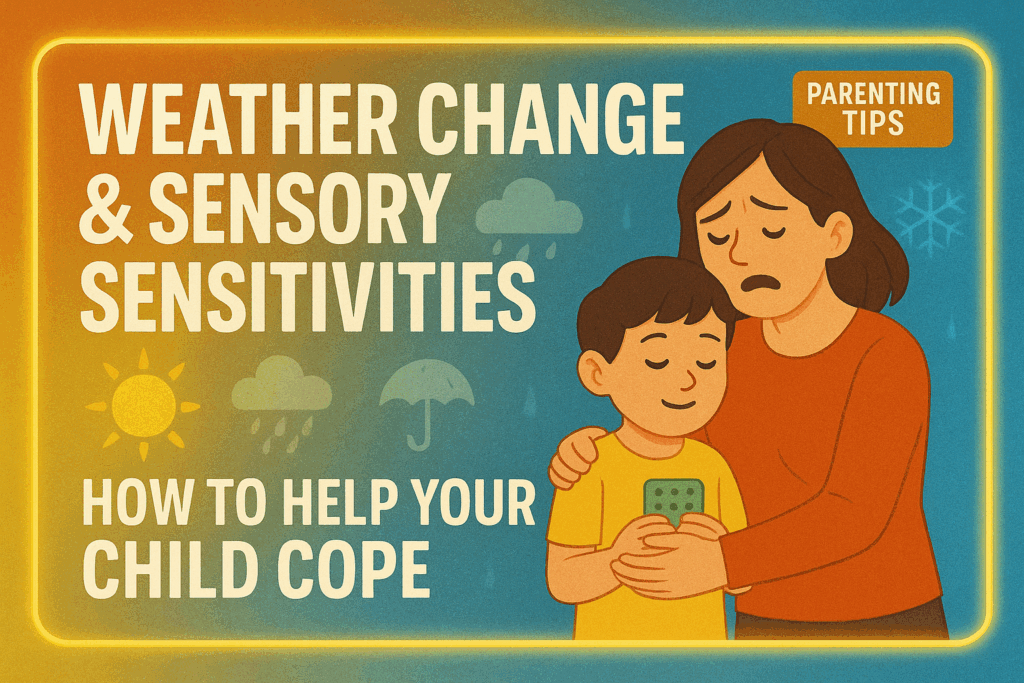Introduction

Weather changes can be challenging for all of us, but for children with sensory sensitivities—such as those with autism, ADHD, or sensory processing disorder (SPD)—shifts in temperature, humidity, barometric pressure, and sunlight can be overwhelming. These changes may trigger anxiety, meltdowns, or physical discomfort, making daily routines difficult.
As a parent or caregiver, understanding how weather impacts sensory-sensitive children and learning coping strategies can make a significant difference in their comfort and emotional well-being. In this comprehensive guide, we’ll explore:
- How Weather Affects Sensory Sensitivities
- Common Weather-Related Sensory Challenges
- Practical Strategies to Help Your Child Cope
- Creating a Sensory-Friendly Environment
- When to Seek Professional Support
By the end of this article, you’ll have actionable tips to support your child through seasonal transitions and unpredictable weather patterns.
1. How Weather Affects Sensory Sensitivities
Children with sensory processing differences experience the world more intensely. Their nervous systems may overreact or underreact to environmental stimuli, including weather changes. Here’s how different weather conditions can impact them:
A. Temperature Extremes (Hot & Cold Weather)
- Heat Sensitivity:
- Sweat, sticky clothing, and bright sunlight can cause discomfort.
- Overheating may lead to irritability or meltdowns.
- Cold Sensitivity:
- Layers of clothing may feel restrictive or itchy.
- Cold wind or dry air can trigger tactile defensiveness.
B. Barometric Pressure Changes (Storms & Rainy Weather)
- Some children feel headaches, dizziness, or fatigue before storms.
- The sound of thunder or heavy rain can be distressing for sound-sensitive kids.
C. Wind & Air Movement
- Wind blowing on the skin may feel painful or irritating.
- Whistling sounds can be overwhelming for auditory-sensitive children.
D. Bright Sunlight & Glare
- Fluorescent or natural sunlight can cause visual discomfort, leading to squinting or avoidance.
E. Humidity & Dry Air
- High humidity can make clothing feel heavy and uncomfortable.
- Dry air may cause skin irritation or respiratory sensitivity.
Understanding these triggers is the first step in helping your child manage weather-related sensory challenges.
2. Common Weather-Related Sensory Challenges
Every child is different, but some common struggles include:
A. Clothing Struggles
- Winter: Hats, gloves, and thick socks may feel scratchy or tight.
- Summer: Sunscreen, sweat, and lightweight fabrics can cause discomfort.
B. Transition Difficulties
- Moving from a warm house to cold outdoors (or vice versa) can be jarring.
C. Weather-Induced Anxiety
- Fear of thunderstorms, strong winds, or extreme temperatures.
D. Sleep Disruptions
- Changes in temperature or humidity can affect sleep quality.
Recognizing these challenges helps in developing personalized coping strategies.
3. Practical Strategies to Help Your Child Cope
A. For Hot Weather
✅ Choose Sensory-Friendly Clothing:
- Lightweight, breathable fabrics (cotton, bamboo).
- Seamless socks and loose-fitting clothes.
- Wide-brimmed hats instead of tight caps.
✅ Manage Sun Sensitivity:
- Use sunglasses with UV protection.
- Try tinted visors or sunshades in the car.
- Apply sunscreen with a sensory-friendly texture (spray or lotion based on preference).
✅ Stay Cool & Hydrated:
- Cooling vests or damp washcloths for overheating.
- Frozen fruit snacks to regulate body temperature.
- Frequent water breaks.
B. For Cold Weather
✅ Layer Strategically:
- Soft fleece instead of wool.
- Compression shirts under layers for deep pressure.
- Mittens instead of gloves (if fine motor skills allow).
✅ Minimize Tactile Discomfort:
- Pre-warm clothes in the dryer before wearing.
- Use tagless, seamless winter gear.
✅ Combat Dry Air:
- Humidifiers in bedrooms.
- Hypoallergenic moisturizers for sensitive skin.
C. For Rainy & Stormy Weather
✅ Reduce Noise Sensitivity:
- Noise-canceling headphones during thunderstorms.
- White noise machines to mask rain sounds.
✅ Create a Safe Space:
- A cozy fort with blankets and favorite toys.
- Deep pressure activities (weighted blankets, hugs).
✅ Explain Weather Changes:
- Use social stories or visual charts to prepare for storms.
D. For Windy Days
✅ Protect from Wind Irritation:
- Soft scarves or neck gaiters (if tolerated).
- Windbreakers with smooth linings.
✅ Manage Auditory Sensitivity:
- Ear muffs or earplugs for gusty days.
4. Creating a Sensory-Friendly Environment
A. At Home
- Maintain a consistent indoor temperature.
- Use blackout curtains for light sensitivity.
- Designate a calming corner with sensory tools (fidgets, weighted lap pads).
B. On the Go
- Keep a “sensory survival kit” with:
- Noise-canceling headphones
- Comfort items (chewelry, stress balls)
- Extra clothing layers
C. School & Outdoor Activities
- Communicate with teachers about weather-related needs.
- Request accommodations (indoor recess options if extreme weather).
5. When to Seek Professional Support
If weather-related sensory challenges significantly impact your child’s daily life, consider:
- Occupational Therapy (OT): Helps with sensory integration techniques.
- Behavioral Therapy: For anxiety management.
- Pediatrician Consultation: Rule out underlying conditions (migraines, allergies).
Conclusion
Weather changes don’t have to be a daily struggle for sensory-sensitive children. By understanding their unique needs and implementing these strategies, you can help them navigate seasonal transitions with greater ease.

